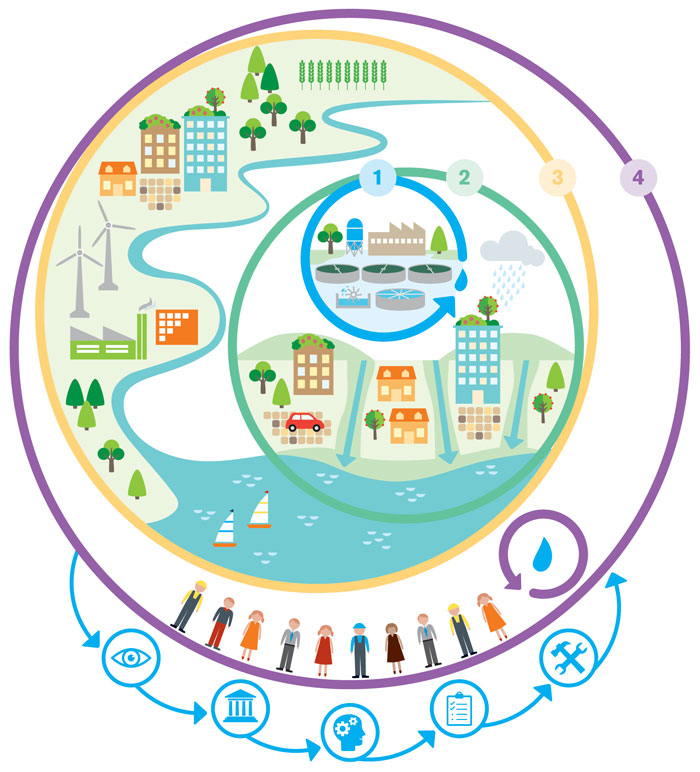Climate change is a constant topic of discussion. Scientists provide evidence, there are marches and inspirational speeches from activists such as Greta Thunberg, countries have adaptation and mitigation plans, yet still politicians’ waiver. People may see climate change as an issue, but maybe something that is not a priority, will not affect them, or something that can be dealt with later. Despite being one of the most momentous issues of our time, climate change is largely invisible to the average human. It is not always evident how it is affecting our wellbeing, ecosystems or how many cities have to take drastic measures to prepare for water shortages from water restrictions to desalination. Only when there are headlines such as the likely possibility of a day zero for Cape Town to run of water does it become clearer and more real on how the changing climate will affect the way we live in our cities and basins.
The specific impacts on each city will depend on the actual changes in climate experienced such as higher temperatures or increased rainfall, which varies from city to city. For example, cities that are located at low elevation in coastal areas will face the combined threat of sea-level rise and storm surges; whereas cities at higher elevation may now experience higher temperatures and vector borne diseases such as malaria.
The rapid pace and scale of urbanization challenges the delivery of water and sanitation services and environmental protection. Impacts of climate change on the water cycle have a direct effect on the available freshwater resources for our cities, affecting both quantity and quality. For example, climate events such as flooding may overwhelm under-provisioned drainage systems and cause toxic wastes to enter water bodies and rivers from informal dumping sites on their banks.
The IWA Principles for Water Wise Cities have four levels of actions, which build on the base principle, that all citizens have access to water and sanitation services, which requires planning, prioritization, monitoring and reporting of the human rights to water and sanitation. Cities can tackle and adapt climate change at these different levels.

Regenerative water and sanitation services
The aim of regenerative services is to ensure public health and satisfy all current needs while protecting the quality and quantity of water resources. Furthermore, regenerative water services are an essential component of climate change adaptation and mitigation strategies leading to carbon neutrality in cities. For example, reusing wastewater can provide an alternative sources of water in water scarce regions, as well; and treating water to different levels of quality depending on the use can reduce the energy and chemicals required for treatment.
Water sensitive urban design
Integrating urban planning with the management, protection and conservation of the total urban water cycle water can enable innovation, social cohesion, creativity and culture. Some of the actions that can be taken support adaptation to changing water availability include: optimising the use of alternative water sources such as reused water for parks and green spaces; design of green spaces which can also serve for water retention and flood mitigation as well as improved liveability. This does municipal support and buy-in on climate adaptation across urban services.
Basin-Connected Cities
By proactively taking part in basin management, the city secures water, food and energy resources, protects water quality, and increases resilience to extreme events The top three risks for citie s include extreme events such as flooding, declining water quality, and challenges to water availability due to increasing water stress and scarcity. These are all exacerbated by a changing climate. Adapting to these risks requires urban stakeholders, including city governments, utilities and industry, to actively engage and contribute to watershed management by working with basin level organisations, their networks and other basin stakeholders (e.g. agriculture, mining, environment, and indigenous and local communities). The drivers, pathways and foundations for action which can support adaptation are outlined in the IWA Action Agenda for Basin-Connected Cities.
Building water wise communities
Adaptation to climate risks people becoming “water-wise” both in terms of their behaviours as citizens, but also as professionals becoming more “water-wise” in their area of expertise. Each stakeholder has a role to play to make a difference. This can include participating in campaigns to reduce water consumption at a household level to citizen groups demanding services that keep storm drains clear of debris which reduces flooding risks. From a professional angle this means plan and implement the best solutions across sectors that account for adapting to a changing climate. For example, city planners can integrate permeable pavements in developments as they can control stormwater at the source, reduce runoff and improve water quality by filtering pollutants. Furthermore, we need policy makers and leaders across scales to recognize and promote the co-benefits of integrating adaptation into design, planning and integration.
Available, sustainable and adaptive management of water and sanitation across cities (from catchment to consumer) relies on the collective action of interdependent stakeholders, playing their role effectively and efficiently. IWA provides a platform for sharing solutions, exploring new ideas and promoting thought-leadership to improve climate resilience and achieve water-wise cities.



